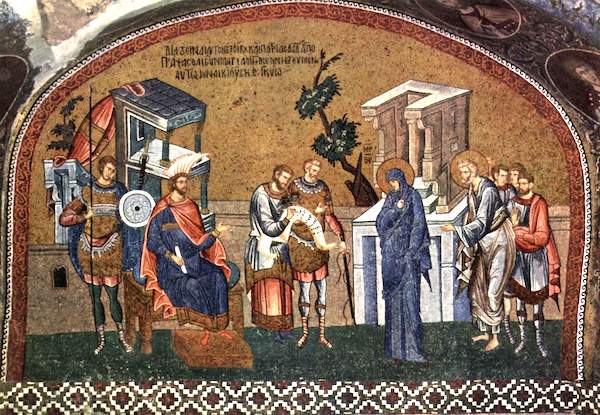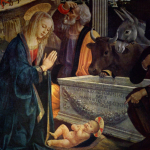Does Luke Contradict Himself on When Jesus Was Born?
by Jimmy Akin
Filed under Historicity, The Incarnation
St. Luke begins the second chapter of his Gospel with a chronological note about when Jesus was born, writing:
"In those days a decree went out from Caesar Augustus that all the world should be enrolled. This was the first enrollment, when Quirinius was governor of Syria." (Luke 2:1-2)
This passage has been subject to a lot of criticism, because Luke has already linked the birth of Jesus to reign of Herod the Great (Luke 1:5), and Quirinius did not become governor of Syria until years afterwards.
What Happened When?
Precisely when Herod’s reign ended is a matter of dispute. Historically, the most common view—which is also in accordance with the Church Fathers—is that Herod died in 1 B.C.
Just over a hundred years ago, however, a German scholar named Emil Schürer argued that Herod died in 4 B.C., and this became the most popular view in the 20th century. More recent scholarship, however, has supported the idea that Schürer was wrong and that the traditional date of 1 B.C. is correct.
After Herod’s death, his kingdom was divided, and his son Archelaus became the ruler of Judaea (Matt. 2:22). Archelaus, however, was a terrible ruler, and in A.D. 6 he was removed from office by the Romans and banished to what is now France. In his place, a Roman prefect was appointed to govern the province, which is why Pontius Pilate—rather than one of the descendants of Herod the Great—was ruling Judaea at the time of Jesus’ adult ministry.
According to the Jewish historian Josephus, Quirinius (aka Cyrenius) was sent to govern Syria after the banishment of Archelaus. He also took a tax census of Judaea at this time and made an accounting of Archelaus’s finances (Josephus, Jewish Antiquities 18:1:1).
The Sequence
From the above, the overall sequence of events is clear:
- Herod the Great dies (1 B.C. or 4 B.C.)
- Archelaus becomes his successor in Judaea
- Archelaus is deposed
- Quirinius does his census (A.D. 6)
Given that sequence, if Luke identified Jesus’ birth with a census conducted in A.D. 6 then we would have an implicit contradiction with Luke 1, which links Jesus’ birth to the reign of Herod the Great, and an even clearer contradiction with Matthew 2, which is explicit about the fact that Jesus was born during the reign of Herod the Great.
Finding a Solution
Scholars have proposed a number of solutions to this. There isn’t space to review them all here, but I’d like to look at one of them. In his book Who Was Jesus? the former Anglican bishop N. T Wright states:
"The question of Quirinius and his census is an old chestnut, requiring a good knowledge of Greek. It depends on the meaning of the word protos, which usually means ‘first’.
Thus most translations of Luke 2:2 read ‘this was the first [protos] census, when Quirinius was governor of Syria’, or something like that.
But in the Greek of the time, as the standard major Greek lexicons point out, the word protos came sometimes to be used to mean ‘before’, when followed (as this is) by the genitive case." (p. 89)
The genitive case is a grammatical feature in Greek. It is often used to indicate possession (as in “Jesus’ disciples”) or origin (as in “Jesus of Nazareth”). Wright, however, is pointing to a special use of the genitive when it follows the word protos and protos ends up meaning “before.” He writes:
"A good example is in John 1:15, where John the Baptist says of Jesus ‘he was before me’, with the Greek being again protos followed by the genitive of ‘me’."
In a footnote, Wright continues:
"The phrase is repeated in John 1:30; compare also 15:18, where Jesus says ‘the world hated me before [it hated] you’, where again the Greek is protos with the genitive.
Other references, in biblical and non-biblical literature of the period, may be found in the Greek Lexicon of Liddell and Scott (Oxford: OUP, 1940), p. 1535, and the Greek-English Lexicon of the New Testament of W . Bauer, revised and edited by Arndt, Gingrich and Danker (Chicago: University of Chicago Press), pp. 725f. 19.
This solution has been advanced by various scholars, including, interestingly, William Temple in his Readings in St John’s Gospel (London: Macmillan, 1945), p. 17; cf. most recently John Nolland, Luke 1–9: 20 (Dallas: Word Books, 1989), pp. 101f."
Wright’s Solution
Wright then explains how this can relate to the enrollment of Quirinius:
"I suggest, therefore, that actually the most natural reading of the verse is: 'This census took place before the time when Quirinius was governor of Syria.'"
He also notes:
"This solves an otherwise odd problem: why should Luke say that Quirinius’ census was the first? Which later ones was he thinking of?
This reading, of course, does not resolve all the difficulties. We don’t know, from other sources, of a census earlier than Quirinius’. But there are a great many things that we don’t know in ancient history.
There are huge gaps in our records all over the place. Only those who imagine that one can study history by looking up back copies of the London Times or the Washington Post in a convenient library can make the mistake of arguing from silence in matters relating to the first century.
My guess is that Luke knew a tradition in which Jesus was born during some sort of census, and that Luke knew as well as we do that it couldn’t have been the one conducted under Quirinius, because by then Jesus was about ten years old. That is why he wrote that the census was the one before that conducted by Quirinius."
An Objection
An objection that some have raised about this solution is why, on this theory, Luke would bother mentioning Quirinius’s census.
Think about it for a moment: It can sound a little strange to say, “This census took place before the time when Quirinius was governor of Syria.”
Why would Luke do that?
There are at least three reasons . . .
Avoiding Confusion
The census of Quirinius was famous enough that Luke’s audience would have heard of it—otherwise he wouldn’t have bothered mentioning it.
Given that it was well known, Luke would have wanted to avoid people confusing it with the enrollment during which Jesus was born.
He would especially want to avoid confusion in light of what he had established about King Herod...
Herod’s Death
Previously, in Luke 1:5, the Evangelist established that John the Baptist was conceived by his mother Elizabeth during the reign of Herod the Great.
Then, in 1:26 and 36, he established that Gabriel announced the conception of Jesus “in the sixth month” (i.e., what we would call the fifth month) of Elizabeth’s pregnancy. This means that Jesus would have been conceived much too early to have been born during Quirinius’s census.
Since Luke has already established this, it gives him a reason—when he records the fact that Jesus was born in connection with an enrollment—that it was not the famous census of Quirinius. It was an earlier one, in keeping with the timeframe Luke has already established.
But there is another reason why Luke would want to point this out...
In the Fifteenth Year of Tiberius Caesar
Luke 2 begins with a time cue that connects the birth of Jesus to the reign of Augustus Caesar. Luke 3 begins with an even more elaborate time cue linking the beginning of Jesus’ adult ministry to the reign of Augustus’s successor, Tiberius.
Luke writes:
"In the fifteenth year of the reign of Tiberius Caesar, Pontius Pilate being governor of Judea, and Herod being tetrarch of Galilee, and his brother Philip tetrarch of the region of Ituraea and Trachonitis, and Lysanias tetrarch of Abilene, in the high-priesthood of Annas and Caiaphas, the word of God came to John the son of Zechariah in the wilderness." (Luke 3:1-2)
The fifteenth year of Tiberius Caesar is what we would call A.D. 28/29.
After John’s ministry begins, Jesus quickly comes and is baptized, thus beginning his own ministry. When that happens, Luke informs us:
"Jesus, when he began his ministry, was about thirty years of age." (Luke 3:23)
If you back up 30 years from A.D. 28/29 (remembering that there is no “year 0” so you skip from A.D. 1 directly to 1 B.C.), you land in 2/3 B.C., which is the year that the early Church Fathers overwhelmingly assign Jesus’ birth to.
People back then knew when Tiberius reigned, and they could do the math as well as we. In fact, since they were used to dating years in terms of the emperor’s reign, they would realize even more quickly than we the year in which Luke 3 indicates Jesus was born.
Thus, on Wright’s theory, Luke would have an additional motive to make sure there was no confusion about Jesus being born during the famous census of Quirinius.
Think about it from Luke’s point of view: After years of gathering his research, he’s now drafting his Gospel, and, when he reaches Luke 2, he includes a time cue for the birth of Jesus during an enrollment ordered by Augustus. He already knows, however, that he is planning on beginning Luke 3 with a time due identifying the beginning of John the Baptist’s ministry and that he’s going to give Jesus’ approximate age at the time of his own ministry’s commencement.
Since the later time cues he’s planning to give point to a date earlier than the famous census of Quirinius, Luke would want to head off any potential confusion by stressing that this happened before that census, in keeping with the implications of Luke 3.
PS. If you like the information I've presented here, you should join my Secret Information Club. If you're not familiar with it, the Secret Information Club is a free service that I operate by email. I send out information on a variety of fascinating topics connected with theology, science, history, and more.
Just sign up at www.SecretInfoClub.com or use this handy sign-up form:
If you have any difficulty, email me at jimmy@secretinfoclub.com.
Originally posted at Catholic Answers. Used with permission.
Related Posts
Note: Our goal is to cultivate serious and respectful dialogue. While it's OK to disagree—even encouraged!—any snarky, offensive, or off-topic comments will be deleted. Before commenting please read the Commenting Rules and Tips. If you're having trouble commenting, read the Commenting Instructions.













